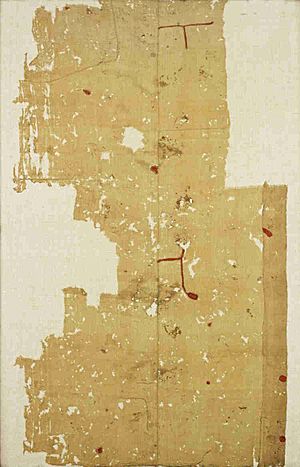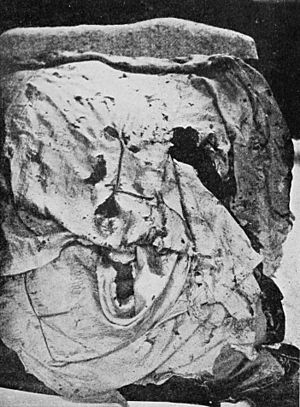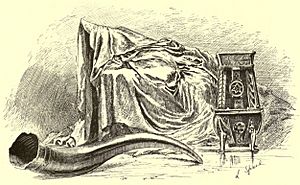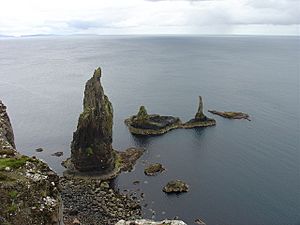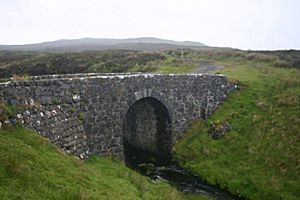Fairy Flag facts for kids
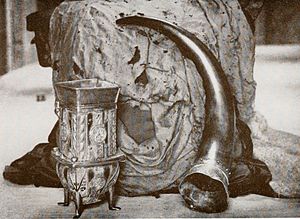
The Fairy Flag (in Scottish Gaelic: Am Bratach Sìth) is a very old and special treasure belonging to the leaders of the Clan MacLeod. It's kept safe at Dunvegan Castle in Scotland, along with other important family items like the Dunvegan Cup and Sir Rory Mor's Horn. People believe the Fairy Flag has magical powers and comes from the world of fairies.
The flag is made of silk and is yellowish or brownish. It's a square, about 18 inches (46 cm) on each side. Over the years, it has become ripped and tattered, and it's now very fragile. The flag has tiny red "elf dots" on it. Some people think the silk came from far away in the East, making it very valuable. This led some to believe it might be a special relic. Others have wondered if it was linked to the Crusades or even a raven banner used by Viking leaders.
Many stories and legends are connected to the flag, mostly about its magic and how it came to be. Some say it was a gift from fairies to a baby chief. Others believe it was given by a fairy-lover or as a reward for beating an evil spirit. The flag is said to have amazing powers, like making a clan's army bigger, saving lives, curing animal sickness, helping with fertility, and even bringing herring fish into the loch at Dunvegan. Some stories warn that if the flag is waved more than three times, it will either disappear or lose its magic forever.
Old clan traditions say the Fairy Flag was looked after by a special family of standard bearers. Only the oldest man in this family was allowed to wave the flag. The first of these flag bearers was even buried in the same tomb as the chiefs on the sacred island of Iona. People say the flag was waved in battles in the 1400s and 1500s, and its magic helped win at least one fight. Another old story from the 1800s linked the flag to a prophecy about the MacLeod clan's future. It said the clan would face hard times but would later become powerful and respected again. In the mid-1900s, the Fairy Flag was said to have helped put out a fire at Dunvegan Castle. It also supposedly brought good luck to soldiers flying bombing missions during the Second World War.
Contents
What the Fairy Flag Looks Like
In the 1800s, a writer named Norman Macleod remembered seeing the Fairy Flag as a child around 1799. He said it had crosses made of gold thread and several "elf spots" stitched on it. He also recalled that small pieces were taken off the flag over time because it was so old and fragile.
In 1814, Sir Walter Scott visited Dunvegan Castle and wrote about the flag. He described it as a "pennon of silk, with something like round red rowan-berries wrought upon it." Later, in 1871, John Francis Campbell saw it and called it "yellow raw silk with figures and spots worked on it in red."
By 1927, Roderick Charles MacLeod described the flag as square and brown, measuring about 18 inches (46 cm) on each side. He thought it was originally much bigger. He also noted how fragile it was and that it should be handled very carefully. By then, the gold crosses Norman Macleod mentioned were gone, but the "elf spots" remained. He also saw that some tears in the flag had been carefully mended.
Experts from the Victoria and Albert Museum examined the flag in the early 1900s. They believed the silk was made in Syria or Rhodes and that the repairs were done in the Near East. They thought the flag was very valuable when new, possibly a relic like a saint's shirt. The Dunvegan Castle website says experts have dated the flag to between the 4th and 7th centuries. This means it's hundreds of years older than the Crusades. Today, the flag is still kept at Dunvegan Castle.
Stories and Legends of the Flag
Early Accounts (1772)
In 1772, Thomas Pennant visited the Hebrides and wrote about the Fairy Flag. He said its name was "Braolauch shi" and that it was given to the MacLeods by Titania, the queen of the fairies. Titania blessed the flag, saying its powers would appear when it was waved three times. But on the third time, the flag and the person waving it would disappear forever.
A family called "Clan y Faitter" was in charge of carrying the flag. For their service, they were given free land. Pennant said the flag had already been used three times. The first time was in a battle between the MacLeods and the Macdonalds. When the flag was waved, the MacLeod army grew ten times bigger! The second time, it was used to save the life of the chief's wife, which also saved the clan's future leader. Pennant then claimed the flag was waved a third time to save his own life. He joked that by then, the flag was so tattered that Titania didn't want it back. Pennant also noted that the MacLeods believed they had Norse ancestors, like the Vikings who used magical raven banners.
Old Manuscript Stories (1800s)
Many traditional stories about the Fairy Flag come from old handwritten documents. One detailed manuscript from around 1800, and another called the Bannatyne manuscript from the 1830s, tell us a lot.
Guardians of the Flag
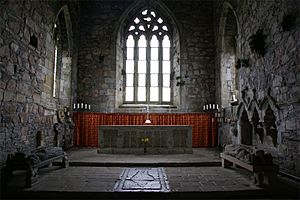
The old manuscripts say that the honor and survival of the Clan MacLeod depended on keeping the Fairy Flag safe. Only the bravest and most important men were chosen to guard the flag when it was displayed. Twelve men, with swords, would stand behind the chief.
One special family, called "Clan Tormad Vic Vurichie", were the hereditary keepers of the flag. Only the oldest living man in this family could wave it. The first flag bearer from this family was buried in the same grave as the clan chief on the island of Iona. The last flag bearer was buried in a grand tomb at St Clements Church on Harris. This tomb was very deep, and it was said that when a new flag bearer was buried, the bones of the previous one would fall through a grate to the bottom. The manuscript writer said that the last man of this family was buried this way in his father's time, and then the tomb was sealed. This family became very poor before they died out.
The Flag at Bloody Bay
The Bannatyne manuscript says the flag was waved at the Battle of Bloody Bay in 1480. During the battle, the chief, William Dubh, was killed, and his clan started to lose hope. A priest then told the flag bearer, Murcha Breac, to wave the Fairy Flag to encourage the clan. Even though the MacLeods of Harris and Dunvegan were fighting against their relatives, the MacLeods of Lewis, the Lewis MacLeods switched sides when they saw the flag. Sadly, both MacLeod clans lost the battle. Many MacLeods died, including Murcha Breac and the twelve flag guardians. William Dubh and Murcha Breac were buried together on Iona, which was a great honor for Murcha Breac.
The Flag at Glendale

The Bannatyne manuscript also says the Fairy Flag was used in the Battle of Glendale around 1490. During this fight, both MacLeod clans were about to lose to the invading MacDonalds. At that moment, the mother of Alasdair Crotach, the MacLeod chief, ordered the Fairy Flag to be waved. This made both MacLeod clans fight with new strength, and even though they lost many men, they won the battle. The flag bearer, Paul Dubh, carried the flag until he died in the fight. The manuscript says Paul Dubh was honorably buried in a deep stone coffin with a metal grate, similar to the one mentioned earlier. It says each flag bearer was buried there, and the writer's grandfather saw the last burial ceremony in the 1700s.
How the Flag Began (Legend)
An old manuscript from around 1800 tells a legend about how the Fairy Flag started. It says a MacLeod went on a Crusade to the Holy Land. On his way home, he met a hermit who warned him about a dangerous spirit guarding a mountain pass. With help from a piece of the True Cross and the hermit's advice, the MacLeod defeated the "She Devil." In return, she told him "the future destinies of the Clan." This knowledge was supposedly kept by his family until they died out. The spirit then gave the MacLeod her girdle and told him to turn it into a banner using his spear as a pole. The manuscript writer said the spear was later lost, and so were the secrets. The writer also thought the flag probably came from the Holy Land and was brought back by this Crusader.
Other Stories
The 1800 manuscript also said that the flag was meant to disappear if it was waved a third time. This final waving would either give the clan a huge victory or lead to their complete downfall. The writer said that the clan always avoided waving it a third time, and by his time, the flag was too small and fragile to be waved again. He even had a small piece of it himself.
The manuscript also mentioned that the flag was once kept in an iron chest at Dunvegan Castle. The key to this chest was always held by the hereditary flag bearers. One story tells how someone tried to steal the flag after a chief died, hoping to gain favor with the next heir. The flag was found, but the staff and iron chest were never seen again.
A Prophecy Comes True (Partially)
Later in his life, Norman Macleod (1783–1862) told his daughter about an old Gaelic prophecy concerning the flag. He said some parts of it seemed to come true when he was a child. The prophecy said that when certain things happened, like a specific Norman dying, or the "Maidens" of MacLeod (some famous rocks) being sold, or a fox having cubs in the castle, and especially when the Fairy Flag was shown for the last time, then the MacLeod family's glory would fade. Much of their land would be sold, and only a small boat could carry all the MacLeod gentlemen across Loch Dunvegan. But, it also said that far in the future, another "John Breac" would appear to get the lands back and make the clan even more powerful than before.
Norman Macleod then said that as a child, he secretly saw the chest holding the flag being forced open. He described the flag as a square cloth with gold crosses and "elf spots." Soon after, they learned that the heir, Norman, had died at sea. Around the same time, the MacLeod's Maidens rocks were sold. He also personally saw a fox with cubs in the castle turret. He was glad that the worst part of the prophecy hadn't come true, and the family still owned their ancestral lands.
In the early 1900s, R. C. MacLeod felt that this prophecy seemed to have come true. At that time, the MacLeod chief had no clan gentlemen living on his estate. Also, an heir named "Ian Breac" was killed in the First World War. R. C. MacLeod still hoped that the prophecy about "John Breac" restoring the family's fortunes would come true.
Walter Scott's Visit (1814)
When Sir Walter Scott visited Dunvegan Castle in 1814, he heard several traditional tales about the Fairy Flag. He was told it had three magical powers:
- It could make the number of men on a battlefield multiply.
- If placed on a wedding bed, it would ensure fertility.
- It could bring herring fish into the loch.
Other Flag Traditions
In the early 1900s, R. C. MacLeod wrote down more traditions about the flag. One said the flag came to the MacLeods from a fairy. Another similar story is about a fairy lullaby.
The Fairy Lover
One story says a MacLeod chief married a fairy. After twenty years, she had to leave him and go back to fairyland. She said goodbye at the Fairy Bridge (about 3 miles or 5 km from Dunvegan) and gave him the flag. She promised that if it was waved during danger, help would come three times. Another version says that after the third time, an invisible being would take the flag and its bearer away forever.
The Fairy Lullaby
R. C. MacLeod thought the "fairy lover" story was linked to a lullaby tradition. This story came from Neil MacLeod, a clan poet in the late 1800s, who heard it from old women. It says that one autumn night, a beautiful fairy visited Dunvegan Castle. She went into the nursery where the baby chief was sleeping. The nursemaid was frozen by a spell and could only watch as the fairy held the baby and sang him a lullaby. The song was so special that the nursemaid remembered it and later sang it to the baby. People believed that any baby chief sung this lullaby would be protected by fairies. For a long time, only nurses who knew this song were hired. The custom stopped for about 200 years because no chief was born in the castle. But R. C. MacLeod said a nurse sang this lullaby in 1847 for his infant elder brother, who later became the 27th chief.
The Fairy Music
Another story tells of events after a new chief was born. There was a big party at Dunvegan Castle. The baby's nursemaid wanted to join the fun and left the baby alone. When the baby cried from cold, no human could hear him. But a group of fairies appeared and wrapped the baby in the Fairy Flag. When the nursemaid brought the baby, wrapped in the flag, to the party, everyone was amazed. The room filled with the fairies' song, which said the flag had the power to save the clan three times. After the song, the flag was taken from the baby and locked in a chest, where it has been kept ever since.
Eastern Origins Story
R. C. MacLeod also shared a story similar to the Crusader legend. In this version, a MacLeod joined a Crusading army and went to the Holy Land. In the desert, he met a witch and escaped her. He then crossed a river where a fairy maiden appeared and blocked his way. After a struggle, MacLeod won and became friends with her. Before they parted, she gave him a box with smaller boxes inside. The innermost box held a magic banner. If waved, it would bring an army to help its owner. The fairy warned him not to open the box for a year and a day, or no crops, livestock, or children would be born on his land. When MacLeod returned home, he gave the box to the chief's wife. She ignored the warning and opened it. Immediately, an army appeared, and that year, no children were born. The story ends by saying the flag has been kept ever since for a time when such an army might save the clan.
Waved Many Times
R. C. MacLeod wrote about another tradition that said the flag was waved in a battle in Waternish around 1580. Another story says it was waved during a terrible cattle plague and stopped the sickness. R. C. MacLeod believed the flag was only waved twice, so he didn't think it was used at the Battle of Bloody Bay because the MacLeods lost that fight. He also wondered if it was waved in 1600 when the clan was in a desperate war with the Macdonalds of Sleat.
The Flag's Powers in the 1900s
In 1938, a fire broke out at Dunvegan Castle. According to Sir Iain Moncreiffe of that Ilk, the flames stopped when the flag was carried past to safety. During the Second World War, the clan chief, Dame Flora MacLeod of MacLeod, received a letter from a clan member. He said that carrying a photo of the flag in his pocket brought him good luck during bombing missions over Germany.


